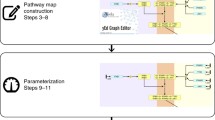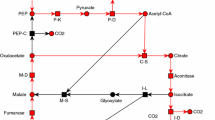Abstract
This article combines Bayes’ theorem with flows of probabilities, flows of evidences (likelihoods), and fundamental concepts for learning Bayesian networks as biological models from data. There is a huge amount of biological applications of Bayesian networks. For example in the fields of protein modeling, pathway modeling, gene expression analysis, DNA sequence analysis, protein–protein interaction, or protein–DNA interaction. Usually, the Bayesian networks have to be learned (statistically constructed) from array data. Then they are considered as an executable and analyzable model of the data source. To improve that, this work introduces a Petri net representation for the propagation of probabilities and likelihoods in Bayesian networks. The reason for doing so is to exploit the structural and dynamic properties of Petri nets for increasing the transparency of propagation processes. Consequently the novel Petri nets are called “probability propagation nets”. By means of examples it is shown that the understanding of the Bayesian propagation algorithm is improved. This is of particular importance for an exact visualization of biological systems by Bayesian networks.











Similar content being viewed by others
Notes
The proof that high-level PPNs completely represent the Bayesian message propagation is sketched in Pinl (2007).
References
Friedman N (2004) Inferring cellular networks using probablistic graphical models. Science 303. http://www.sciencemag.org
Hinneburg A (2007) Klassifikation. Lecture Notes for the Course ‘Web Data Mining’. Martin-Luther-Universität Halle-Wittenberg, Germany
Lautenbach K (1973) Exakte Bedingungen der Lebendigkeit für eine Klasse von Petri-Netzen. PhD thesis, Gesellschaft für Mathematik und Datenverarbeitung Bonn
Lautenbach K (1986) Linear algebraic techniques for place/transition nets. In: Brauer W, Reisig W, Rozenberg G (eds) Advances in petri nets, Lecture Notes in Computer Science, vol 254. Springer, Berlin, pp 142–167
Lautenbach K, Philippi S, Pinl A (2006) Bayesian networks and petri nets. In: Proceedings of the workshop “Entwurf komplexer Automatisierungssysteme” (EKA) 2006, Braunschweig
Neapolitan RE (1990) Probabilistic reasoning in expert systems: theory and algorithms. Wiley, New York, NY, USA
Needham CJ, Bradford JR, Bulpitt AJ, Westhead DR (2006) Inference in Bayesian networks. Nat Biotechnol 24(1):51–53. http://www.comp.leeds.ac.uk/chrisn/research/nbt0106-51.pdf
Needham CJ, Bradford JR, Bulpitt AJ, Westhead DR (2007) A primer on learning in Bayesian networks for computational biology. PLoS Comput Biol 3(8):1409–1416. http://www.view.ncbi.nlm.nih.gov/pubmed/17784779
Nilsson NJ (1986) Probabilistic logic. Artif Intell 28(1):71–88
Pearl J (1988) Probabilistic reasoning in intelligent systems: networks of plausible inference. Morgan Kaufmann Publishers Inc., San Francisco, CA, USA
Petri CA (1962) Kommunikation mit Automaten. Tech. Rep., Schriften des Institutes für instrumentelle Mathematik, Bonn
Pinl A (2007) Probability propagation nets—unveiling structure and propagations of Bayesian networks by means of petri nets. PhD thesis, Universität Koblenz-Landau, Koblenz. http://www.kola.opus.hbz-nrw.de/volltexte/2008/274/
Wikipedia (2008) Microarray—wikipedia, Die freie Enzyklopädie. http://www.de.wikipedia.org/w/index.php?title=Microarray&oldid=42972720. Online 02/2008
Author information
Authors and Affiliations
Corresponding author
Rights and permissions
About this article
Cite this article
Lautenbach, K., Pinl, A. A Petri net representation of Bayesian message flows: importance of Bayesian networks for biological applications. Nat Comput 10, 683–709 (2011). https://doi.org/10.1007/s11047-009-9142-z
Received:
Accepted:
Published:
Issue Date:
DOI: https://doi.org/10.1007/s11047-009-9142-z




